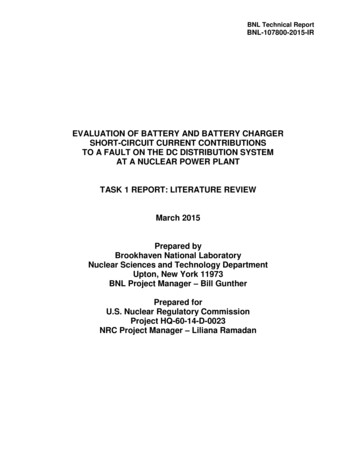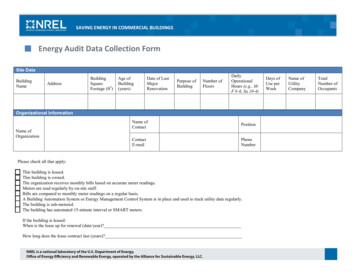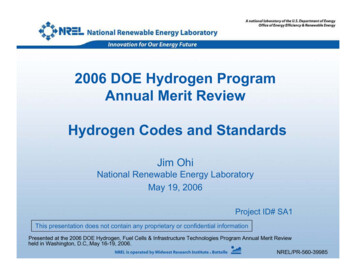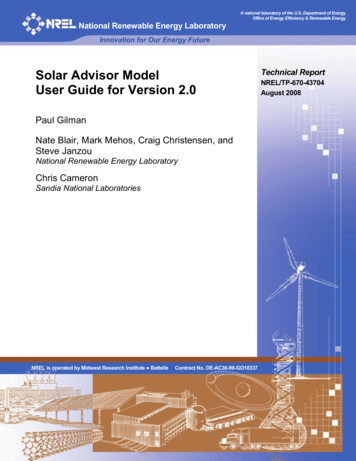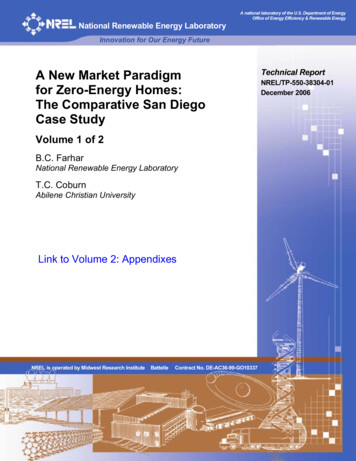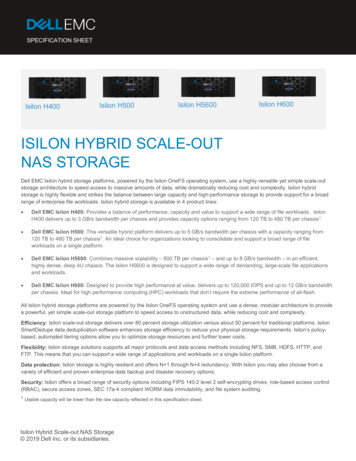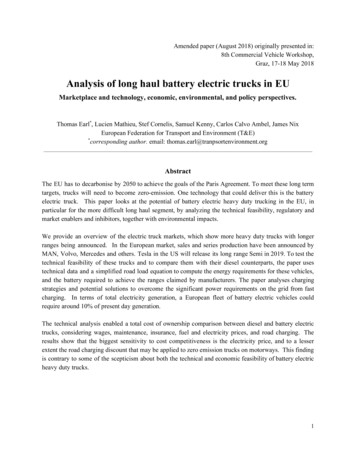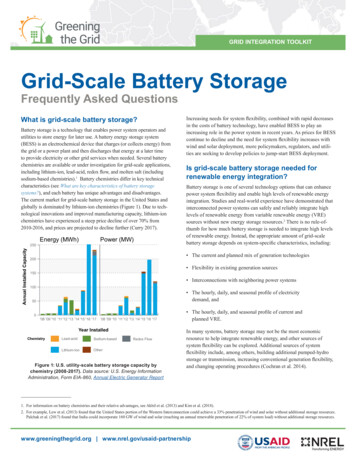
Transcription
GRID INTEGRATION TOOLKITGrid-Scale Battery StorageFrequently Asked QuestionsWhat is grid-scale battery storage?Battery storage is a technology that enables power system operators andutilities to store energy for later use. A battery energy storage system(BESS) is an electrochemical device that charges (or collects energy) fromthe grid or a power plant and then discharges that energy at a later timeto provide electricity or other grid services when needed. Several batterychemistries are available or under investigation for grid-scale applications,including lithium-ion, lead-acid, redox flow, and molten salt (includingsodium-based chemistries).1 Battery chemistries differ in key technicalcharacteristics (see What are key characteristics of battery storagesystems?), and each battery has unique advantages and disadvantages.The current market for grid-scale battery storage in the United States andglobally is dominated by lithium-ion chemistries (Figure 1). Due to technological innovations and improved manufacturing capacity, lithium-ionchemistries have experienced a steep price decline of over 70% from2010-2016, and prices are projected to decline further (Curry 2017).Annual Installed Capacity250Energy (MWh)Power (MW)Increasing needs for system flexibility, combined with rapid decreasesin the costs of battery technology, have enabled BESS to play anincreasing role in the power system in recent years. As prices for BESScontinue to decline and the need for system flexibility increases withwind and solar deployment, more policymakers, regulators, and utilities are seeking to develop policies to jump-start BESS deployment.Is grid-scale battery storage needed forrenewable energy integration?Battery storage is one of several technology options that can enhancepower system flexibility and enable high levels of renewable energyintegration. Studies and real-world experience have demonstrated thatinterconnected power systems can safely and reliably integrate highlevels of renewable energy from variable renewable energy (VRE)sources without new energy storage resources.2 There is no rule-ofthumb for how much battery storage is needed to integrate high levelsof renewable energy. Instead, the appropriate amount of grid-scalebattery storage depends on system-specific characteristics, including: The current and planned mix of generation technologies200 Flexibility in existing generation sources150 Interconnections with neighboring power systems100 The hourly, daily, and seasonal profile of electricitydemand, and500'08 '09 '10 '11 '12 '13 '14 '15 '16 '17'08 '09 '10 '11 '12 '13 '14 '15 '16 '17Year OtherRedox FlowFigure 1: U.S. utility-scale battery storage capacity bychemistry (2008-2017). Data source: U.S. Energy InformationAdministration, Form EIA-860, Annual Electric Generator Report The hourly, daily, and seasonal profile of current andplanned VRE.In many systems, battery storage may not be the most economicresource to help integrate renewable energy, and other sources ofsystem flexibility can be explored. Additional sources of systemflexibility include, among others, building additional pumped-hydrostorage or transmission, increasing conventional generation flexibility,and changing operating procedures (Cochran et al. 2014).1. For information on battery chemistries and their relative advantages, see Akhil et al. (2013) and Kim et al. (2018).2. For example, Lew et al. (2013) found that the United States portion of the Western Interconnection could achieve a 33% penetration of wind and solar without additional storage resources.Palchak et al. (2017) found that India could incorporate 160 GW of wind and solar (reaching an annual renewable penetration of 22% of system load) without additional storage resources.www.greeningthegrid.org www.nrel.gov/usaid-partnership
2Grid-Scale Battery Storage: Frequently Asked QuestionsWhat are the key characteristics of batterystorage systems? Rated power capacity is the total possible instantaneous dischargecapability (in kilowatts [kW] or megawatts [MW]) of the BESS, orthe maximum rate of discharge that the BESS can achieve, startingfrom a fully charged state. Energy capacity is the maximum amount of stored energy (inkilowatt-hours [kWh] or megawatt-hours [MWh]) Storage duration is the amount of time storage can discharge at itspower capacity before depleting its energy capacity. For example, abattery with 1 MW of power capacity and 4 MWh of usable energycapacity will have a storage duration of four hours. Cycle life/lifetime is the amount of time or cycles a battery storagesystem can provide regular charging and discharging before failure orsignificant degradation. Self-discharge occurs when the stored charge (or energy) of thebattery is reduced through internal chemical reactions, or withoutbeing discharged to perform work for the grid or a customer.Self-discharge, expressed as a percentage of charge lost over a certainperiod, reduces the amount of energy available for discharge and is animportant parameter to consider in batteries intended for longer-duration applications. State of charge, expressed as a percentage, represents the battery’spresent level of charge and ranges from completely discharged tofully charged. The state of charge influences a battery’s ability toprovide energy or ancillary services to the grid at any given time. Round-trip efficiency, measured as a percentage, is a ratio of theenergy charged to the battery to the energy discharged from thebattery. It can represent the total DC-DC or AC-AC efficiency ofthe battery system, including losses from self-discharge and otherelectrical losses. Although battery manufacturers often refer to theDC-DC efficiency, AC-AC efficiency is typically more important toutilities, as they only see the battery’s charging and discharging fromthe point of interconnection to the power system, which uses AC(Denholm 2019).What services can batteries provide?Arbitrage: Arbitrage involves charging the battery when energy pricesare low and discharging during more expensive peak hours. For theBESS operator, this practice can provide a source of income by takingadvantage of electricity prices that may vary throughout the day. Oneextension of the energy arbitrage service is reducing renewable energycurtailment. System operators and project developers have an interestin using as much low-cost, emissions-free renewable energy generationas possible; however, in systems with a growing share of VRE, limitedflexibility of conventional generators and temporal mismatches betweenrenewable energy supply and electricity demand (e.g., excess wind3. See Mills and Wiser (2012) for a general treatment on the concept of capacity credit.generation in the middle of the night) may require renewable generatorsto curtail their output. By charging the battery with low-cost energyduring periods of excess renewable generation and discharging duringperiods of high demand, BESS can both reduce renewable energycurtailment and maximize the value of the energy developers can sellto the market. Another extension of arbitrage in power systems withoutelectricity markets is load-leveling. With load-levelling, system operators charge batteries during periods of excess generation and dischargebatteries during periods of excess demand to more efficiently coordinatethe dispatch of generating resources.Firm Capacity or Peaking Capacity: System operators must ensurethey have an adequate supply of generation capacity to reliably meetdemand during the highest-demand periods in a given year, or the peakdemand. This peak demand is typically met with higher-cost generators,such as gas plants; however, depending on the shape of the load curve,BESS can also be used to ensure adequate peaking generation capacity.While VRE resources can also be used to meet this requirement, theseresources do not typically fully count toward firm capacity, as theirgeneration relies on the availability of fluctuating resources and may notalways coincide with peak demand. But system operators can improveVRE’s ability to contribute to firm capacity requirements through pairingwith BESS. Pairing VRE resources with BESS can enable these resourcesto shift their generation to be coincident with peak demand, improvingtheir capacity value (see text box below) and system reliability.3Firm Capacity, Capacity Credit, and CapacityValue are important concepts for understandingthe potential contribution of utility-scale energystorage for meeting peak demand.Firm Capacity (kW, MW): The amount of installedcapacity that can be relied upon to meet demandduring peak periods or other high-risk periods. Theshare of firm capacity to the total installed capacity of agenerator is known as its capacity credit (%).3Capacity Value ( ): The monetary value of thecontribution of a generator (conventional, renewable,or storage) to balancing supply and demand whengeneration is scarce.Operating Reserves and Ancillary Services: To maintain reliablepower system operations, generation must exactly match electricitydemand at all times. There are various categories of operating reservesand ancillary services that function on different timescales, from subseconds to several hours, all of which are needed to ensure grid reliability.BESS can rapidly charge or discharge in a fraction of a second, faster
3Grid-Scale Battery Storage: Frequently Asked Questionsthan conventional thermal plants, making them a suitable resource forshort-term reliability services, such as Primary Frequency Response(PFR) and Regulation. Appropriately sized BESS can also providelonger-duration services, such as load-following and ramping services,to ensure supply meets demand.Transmission and Distribution Upgrade Deferrals: The electricitygrid’s transmission and distribution infrastructure must be sized to meetpeak demand, which may only occur over a few hours of the year. Whenanticipated growth in peak electricity demand exceeds the existinggrid’s capacity, costly investments are needed to upgrade equipment anddevelop new infrastructure. Deploying BESS can help defer or circumvent the need for new grid investments by meeting peak demand withenergy stored from lower-demand periods, thereby reducing congestionand improving overall transmission and distribution asset utilization.Also, unlike traditional transmission or distribution investments, mobileBESS installations can be relocated to new areas when no longer neededin the original location, increasing their overall value to the grid.Black Start: When starting up, large generators need an external sourceof electricity to perform key functions before they can begin generatingelectricity for the grid. During normal system conditions, this externalelectricity can be provided by the grid. After a system failure, however,the grid can no longer provide this power, and generators must be startedthrough an on-site source of electricity, such as a diesel generator, aprocess known as black start. An on-site BESS can also provide thisservice, avoiding fuel costs and emissions from conventional black-startgenerators. As system-wide outages are rare, an on-site BESS canprovide additional services when not performing black starts.Table 1 below summarizes the potential applications for BESS inthe electricity system, as well as whether the application is currentlyvalued in U.S. electricity markets (Denholm 2018). Figure 2 shows thecumulative installed capacity (MW) for utility-scale storage systems inthe United States in 2017 by the service the systems provide.Where should batteries be located?Utility-scale BESS can be deployed in several locations, including: 1)in the transmission network; 2) in the distribution network near loadcenters; or 3) co-located with VRE generators. The siting of the BESShas important implications for the services the system can best provide,and the most appropriate location for the BESS will depend on itsintended-use case.Most storage systems in the United States provideoperating reserves and ancillary services. Despite thiscurrent focus, the total U.S. market for these services islimited, and utility-scale storage may begin providing morefirm and peak capacity in the near future.In many cases, a BESS will be technically capable of providing a broadrange of services in any of the locations described in the next section.Therefore, when siting storage, it is important to analyze the costs andbenefits of multiple locations to determine the optimal siting to meetsystem needs. Considering all combinations of services the BESS canprovide at each potential site will provide a better understanding of theexpected revenue streams (see What is value-stacking?) and impact onthe grid.OperatingReserves andAncillary ServicesIn the Transmission NetworkBESS interconnected to the transmission system can provide a broadrange of ancillary and transmission-related services. These systems canbe deployed to replace or defer investments of peaking capacity, provideoperating reserves to help respond to changes in generation and demand,or they can be used to defer transmission system upgrades in regionsexperiencing congestion from load or generation growth. Figure 3 belowshows the configuration of a utility-scale storage system interconnectedat the transmission substation level.Arbitrage,RE CurtailmentReduction andLoad-levellingFirm Capacityor PeakingCapacityIn the Distribution Network Near Load CentersBlack StartTransmissionand DistributionUpgrade Deferrals0100200300400500600Figure 2: U.S. Utility-scale battery storage capacity byNameplate Capacityservice. Data source: U.S. Energy Information Administration,Form EIA-860, Annual Electric Generator ReportStorage systems located in the distribution network can provide all ofthe services as transmission-sited storage, in addition to several servicesrelated to congestion and power quality issues. In many areas, it may bedifficult to site a conventional generator near load in order to providepeaking capacity, due to concerns about emissions or land use. Due totheir lack of local emissions and their scalable nature, BESS systems canbe co-located near load with fewer siting challenges than conventionalgeneration. Placing storage near load can reduce transmission anddistribution losses and relieve congestion, helping defer transmissionand distribution upgrades. Distribution-level BESS systems can alsoprovide local power quality services and support improved resilienceduring extreme weather events.
4Grid-Scale Battery Storage: Frequently Asked QuestionsTable 1: Applications of Utility-Scale Energy StorageApplicationDescriptionDuration of ServiceProvisionTypically Valued in U.S. ElectricityMarkets?ArbitragePurchasing low-cost off-peak energyand selling it during periods of highprices.HoursYesFirm CapacityProvide reliable capacity to meet peaksystem demand.4 hoursYes, via scarcity pricing and capacitymarkets, or through resource adequacypayments. Primary FrequencyResponseVery fast response to unpredictablevariations in demand and generation.SecondsYes, but only in a limited number ofmarkets. RegulationFast response to random,unpredictable variations in demand andgeneration.15 minutes to 1 hourYes ContingencySpinningFast response to a contingency suchas a generator failure.30 minutes to 2hoursYes Replacement/SupplementalUnits brought online to replace spinningunits.HoursYes, but values are very low. Ramping/LoadFollowingFollow longer-term (hourly) changes inelectricity demand.30 minutes to hoursYes, but only in a limited number ofmarkets.Transmissionand DistributionReplacement andDeferralReduce loading on T&D system duringpeak times.HoursOnly partially, via congestion prices.Black-StartUnits brought online to start systemafter a system-wide failure (blackout).HoursNo, typically compensated throughcost-of-service mechanisms.Operating ReservesCo-Located with VRE GeneratorsRenewable resources that are located far from load centers may requiretransmission investments to deliver power to where it is needed. Giventhe variable nature of VRE resources, the transmission capacity used todeliver the power may be underutilized for large portions of the year.A BESS can reduce the transmission capacity needed to integrate theseresources and increase the utilization of the remaining capacity by usingstorage to charge excess generation during periods of high resourceavailability and discharge during periods of low resource availability.The same BESS can be used to reduce the curtailment of VRE generation, either due to transmission congestion or a lack of adequatedemand, as well as provide a broad range of ancillary services.What is value-stacking? What are someexamples of value-stacking opportunitiesand challenges?BESS can maximize their value to the grid and project developers byproviding multiple system services. As some services are rarely calledfor (i.e., black start) or used infrequently in a given hour (i.e., spinningreserves), designing a BESS to provide multiple services enables ahigher overall battery utilization. This multi-use approach to BESSis known as value-stacking. For example, a BESS project can helpdefer the need for new transmission by meeting a portion of the peakdemand with stored energy during a select few hours in the year. Whennot meeting peak demand, the BESS can earn revenue by providingoperating reserve services for the transmission system operator.
5Grid-Scale Battery Storage: Frequently Asked QuestionsDC -LV ACMV AC inverter/chargerset-uptransformerBMS*set pointsbatteriestie-linestatus infosystemoperator*Battery Management SystemFigure 3: Key components of BESS interconnected at the transmission substation level. LV AC represents a low-voltageAC connection, while MV AC represents a medium-voltage AC connection. 4 Source: Denholm (2019)Some system services may be mutually exclusive depending on theBESS design (e.g., a short duration storage device used to supplyregulating reserves would have limited value for deferring transmissionor distribution upgrades). Even if a BESS is technically capable of providing multiple services, the additional cycling of the battery (chargingand discharging) may degrade the battery and shorten its lifetimeand economic viability. Finally, a BESS can only provide a limitedduration of any set of services before it runs out of charge, which meansbatteries must prioritize the services they provide.4Regulators have a variety of options to enable BESS to maximize itseconomic potential through val ue-stacking. For example, the CaliforniaPublic Utilities Commission (CPUC) developed categories of servicesBESS can provide based on their importance for reliability and locationon the grid, as well as 12 rules for utilities when procuring servicesfrom BESS (CPUC 2018). The CPUC rules: Dictate that BESS projects can only provide services at the voltagelevel to which they are interconnected or higher, but not lower5; Prioritize reliability services over non-reliability services and ensurestorage cannot contract for additional services that would interferewith any obligation to provide reliability services; Require that a BESS project comply with all performance and availability requirements for services it provides and that noncompliancepenalties be communicated in advance; Require that a BESS project inform the utility of any services itcurrently provides or intends to provide; and Take measures to prevent double compensation to BESS projects forservices provided.These CPUC rules are just one example of how regulators can help ensureBESS projects can select the most cost-effective combinations of servicesto provide without negatively impacting the reliability of the grid.How are BESS operators compensated?BESS operators can be compensated in several different ways,including in the wholesale energy market, through bilateral contracts,or directly by the utility through a cost-of-service me
rid-Scale Battery Storage Frequently Asked uestions 3. than conventional thermal plants, making them a suitable resource for short-term

